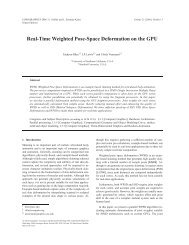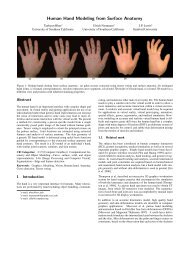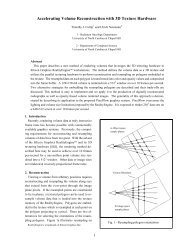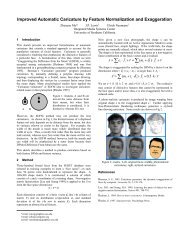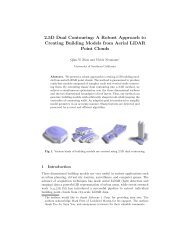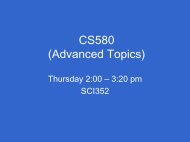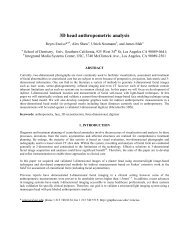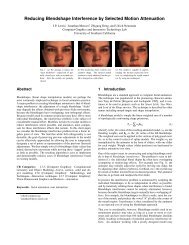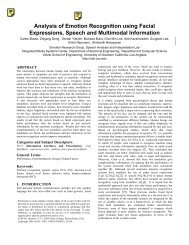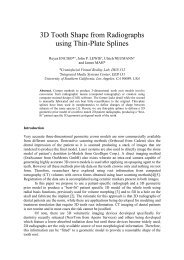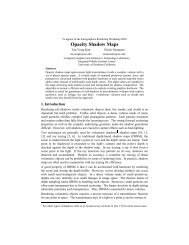Audio-based Head Motion Synthesis for Avatar-based Telepresence ...
Audio-based Head Motion Synthesis for Avatar-based Telepresence ...
Audio-based Head Motion Synthesis for Avatar-based Telepresence ...
You also want an ePaper? Increase the reach of your titles
YUMPU automatically turns print PDFs into web optimized ePapers that Google loves.
<strong>Audio</strong>-<strong>based</strong> <strong>Head</strong> <strong>Motion</strong> <strong>Synthesis</strong> <strong>for</strong> <strong>Avatar</strong>-<strong>based</strong><br />
<strong>Telepresence</strong> Systems<br />
ABSTRACT<br />
Zhigang Deng, Carlos Busso*, Shri Narayanan*, and Ulrich Neumann<br />
Computer Graphics and Immersive Technology (CGIT) Lab, Dept. of Computer Science<br />
Integrated Media System Center, *Dept. of EE-Systems<br />
University of Southern Cali<strong>for</strong>nia, Los Angeles<br />
http://graphics.usc.edu<br />
In this paper, a data-driven audio-<strong>based</strong> head motion synthesis<br />
technique is presented <strong>for</strong> avatar-<strong>based</strong> telepresence<br />
systems. First, head motion of a human subject speaking<br />
a custom corpus is captured, and the accompanying audio<br />
features are extracted. Based on the aligned pairs between<br />
audio features and head motion (audio-headmotion), a K-<br />
Nearest Neighbors (KNN)-<strong>based</strong> dynamic programming algorithm<br />
is used to synthesize novel head motion given new<br />
audio input. This approach also provides optional intuitive<br />
keyframe (key head poses) control: after key head poses<br />
are specified, this method will synthesize appropriate head<br />
motion sequences that maximally meet the requirements of<br />
both the speech and key head poses.<br />
Categories and Subject Descriptors<br />
I.3.7 [Computer Graphics]: Three Dimensional Graphics<br />
and Realism-Animation, Virtual Reality; I.2.6 [Artificial<br />
Intelligence]: Learning-Knowledge acquisition; H.5.1 [Multimedia<br />
In<strong>for</strong>mation Systems]: Animations<br />
General Terms<br />
Algorithms, Design, Experimentation, Human Factors<br />
Keywords<br />
Computer Graphics, Facial Animation, Data-driven, <strong>Head</strong><br />
<strong>Motion</strong> <strong>Synthesis</strong>, K Nearest Neighbor, <strong>Audio</strong>-<strong>based</strong>, Keyframing<br />
Control, <strong>Telepresence</strong> Systems<br />
1. INTRODUCTION<br />
Humans communicate via two channels [1, 2]: an explicit<br />
channel (speech) and an implicit channel (non-verbal gestures).<br />
In computer graphics community, significant ef<strong>for</strong>t<br />
has been made to model the explicit speech channel [3, 4,<br />
5, 6, 7, 8, 9]. However, speech production is often accompanied<br />
by non-verbal gestures, such as head motion and eye<br />
Permission to make digital or hard copies of all or part of this work <strong>for</strong><br />
personal or classroom use is granted without fee provided that copies are<br />
not made or distributed <strong>for</strong> profit or commercial advantage and that copies<br />
bear this notice and the full citation on the first page. To copy otherwise, or<br />
republish, to post on servers or to redistribute to lists, requires prior specific<br />
permission and/or a fee.<br />
ETP’04, October 15, 2004, New York, New York, USA.<br />
Copyright 2004 ACM 1-58113-933-0/04/0010 . . . $5.00.<br />
blinking. The perception study [2] reports that head motion<br />
plays a direct role in the perception of speech <strong>based</strong> on the<br />
evaluation of a speech-in-noise task by Japanese subjects.<br />
Also, adding head motion can greatly enhance the realism<br />
of synthesized facial animation that is being increasingly<br />
used in many fields, e.g. education, communication, and<br />
entertainment industry.<br />
Because of the complexity of the association between the<br />
speech channel and its accompanying head motion, generating<br />
appropriate head motion <strong>for</strong> new audio is a timeconsuming<br />
and tedious job <strong>for</strong> animators. They often manually<br />
make key head poses by referring to the recorded video<br />
of actors reciting the audio/text or capturing the head motion<br />
of real actors using motion capture systems. However,<br />
it is impossible to reuse the captured data/video <strong>for</strong> other<br />
scenarios without considerable ef<strong>for</strong>t. Furthermore, making<br />
appropriate head motion <strong>for</strong> the conversation of multiple humans<br />
(avatars) poses more challenging problems <strong>for</strong> manual<br />
approaches and motion capture methods. And automatic<br />
head motion is a requirement in many applications, such as<br />
autonomous avatars in avatar-<strong>based</strong> telepresence systems,<br />
interactive characters in computer games, etc.<br />
2. PREVIOUS AND RELATED WORK<br />
A comprehensive review on facial animation is beyond this<br />
work, and a recent review can be found in [10]. Recent<br />
relevant research on non-verbal gestures and head motion is<br />
described in this section.<br />
2.1 Non-Verbal Gestures<br />
Pelachaud et al. [11] generate facial expressions and head<br />
movements from labeled text using a set of custom rules,<br />
<strong>based</strong> on Facial Action Coding System (FACS) representations<br />
[12]. Cassell et al. [13] present an automated system<br />
that generates appropriate non-verbal gestures, including<br />
head motion, <strong>for</strong> conversations among multiple avatars,<br />
but they address only the “nod” head motion in their work.<br />
Perlin and Goldberg [14] develop an “Improv” system that<br />
combines procedural and rule-<strong>based</strong> techniques <strong>for</strong> behavior<strong>based</strong><br />
characters. The character actions are predefined, and<br />
decision rules are used to choose the appropriate combinations<br />
and transitions. Kurlander et al. [15] construct a<br />
“comic chat” system that automatically generates 2D comics<br />
<strong>for</strong> online graphical chatting, <strong>based</strong> on the rules of comic<br />
panel composition. Chi et al. [16] present an EMOTE model<br />
by implanting Laban Movement Analysis (LMA) and its ef<strong>for</strong>ts<br />
and shape components into character animation. It is<br />
successfully applied to arm and body movements, but the
applicability of this method to head movements with speech<br />
has not been established. Cassell et al. [17] generate appropriate<br />
non-verbal gestures from text, relying on a set of<br />
linguistic rules derived from non-verbal conversational research.<br />
This method works on text, but the possibility of<br />
applying this method to audio input is not verified yet.<br />
2.2 <strong>Head</strong> <strong>Motion</strong><br />
Researchers have reported that there are strong correlations<br />
between speech and its accompanying head movements<br />
[18, 19, 20, 21, 2]. For example, Munhall et al. [2]<br />
show that the rhythmic head motion strongly correlates with<br />
the pitch and amplitude of the subject’s voice. Graf et<br />
al. [21] estimate the probability distribution of major head<br />
movements (e.g. “nod”) according to the occurrences of<br />
pitch accents. [19, 18] even report that about 80% of the<br />
variance observed <strong>for</strong> fundamental frequency (F0) can be determined<br />
from head motion, although the average percentage<br />
of head motion variance that can be linearly inferred<br />
from F0 is much lower. Costa et al. [20] use the Gaussian<br />
Mixture Model (GMM) to model the association between<br />
audio features and visual prosody. In their work, only eyebrow<br />
movements are analyzed, and the connection between<br />
audio features and head motion is not reported. As such,<br />
a data-driven synthesis approach <strong>for</strong> head motion has not<br />
been published yet.<br />
In this paper, a data-driven technique is presented to automatically<br />
synthesize “appropriate head motion” <strong>for</strong> given<br />
novel speech input. First, head motion is extracted from<br />
the captured data of a human subject, speaking a custom<br />
corpus with different expressions. <strong>Audio</strong> is captured simultaneously.<br />
All the audio-headmotion pairs are collected into<br />
a database indexed by audio features. Next, the audio features<br />
of given new speech (audio) input are used to search<br />
<strong>for</strong> their K nearest neighbors in this database. All such K<br />
chosen nearest neighbors are put into a nearest neighbor<br />
candidate pool, and a dynamic programming algorithm is<br />
used to find the optimum nearest neighbor combination by<br />
minimizing a cost function. This approach also provides<br />
flexible control <strong>for</strong> animators. If key head poses are specified,<br />
this approach will try to maximally satisfy the requests<br />
from speech and key head poses.<br />
The main contributions of this approach are:<br />
• It is fully automatic. It can synthesize appropriate<br />
head motion directly from audio, and it can be used<br />
<strong>for</strong> many applications, e.g. avatar-<strong>based</strong> telepresence<br />
systems and computer games.<br />
• It also provides optional flexible control. By specifying<br />
key head poses, animators can influence the synthesized<br />
head motion. Another control is to the ability<br />
to adjust “searching weights” (Section 5) to meet the<br />
synthesis preference of the animators.<br />
Section 3 describes the acquisition and preprocessing of<br />
both audio and visual data. Section 4 describes how to synthesize<br />
novel head motion given new speech using a KNN<strong>based</strong><br />
dynamic programming technique, and how to search<br />
<strong>for</strong> the optimized weights is discussed (Section 5). Finally,<br />
results and conclusions are described Section 6&7 respectively.<br />
3. DATA ACQUISITION<br />
An actress with markers on her face was captured with<br />
a Vicon motion capture system [22]. The actress was directed<br />
to speak a custom designed corpus composed of about<br />
two hundred sentences, each with four expressions (neutral,<br />
happy, angry and sad) as naturally as possible. At the same<br />
time, the accompanying audio was recorded. This data were<br />
captured <strong>for</strong> a comprehensive research project, and only<br />
head motion data is used in this work. Figure 1 illustrates<br />
the markers used in this process.<br />
Figure 1: Illustration of the markers used in motion<br />
capture. Dark points are three chosen approximately<br />
rigid points.<br />
The following procedure is used to extract the trans<strong>for</strong>mation<br />
of head motion <strong>for</strong> each frame:<br />
1. A specific nose point is assumed to be the local coordinate<br />
center of each frame, and one frame in a neutral<br />
pose is chosen as a reference frame.<br />
2. A local coordinate system is defined by three chosen<br />
approximately rigid points (the nose point and corner<br />
points of the eyes, shown as dark points in Fig 1).<br />
The distance between the nose point in each frame and<br />
that of the reference frame is its translation vector, and<br />
aligning each frame with the reference frame generates<br />
its rotation matrix.<br />
3. Since this trans<strong>for</strong>mation is only composed of rotation<br />
and translation, it can be further decomposed into a<br />
six dimensional trans<strong>for</strong>mation vector [23]: three Euler<br />
angles (converted to “Radians” in this work) and<br />
three translational values. As such, a six dimensional<br />
trans<strong>for</strong>mation vector (T-VEC) is generated.<br />
4. The difference between the T-VECs of two consecutive<br />
frames (suppose ti and ti+1) is the head motion at ti.<br />
The acoustic in<strong>for</strong>mation is extracted using the Praat<br />
speech processing software [24] with a 30-ms window and<br />
21.6-ms of overlap. The audio-features used are the pitch<br />
(F0), the lowest five <strong>for</strong>mants (F1 through F5), 13-MFCC<br />
(Mel-Frequency Cepstral Coefficients) and 12-LPC (Linear
Prediction Coefficient). These 31 dimensional audio feature<br />
vectors are reduced to four dimensions using Principal<br />
Component Analysis (PCA), covering 98.89% of the variation.<br />
An audio feature PCA space expanded by four eigenvectors<br />
(corresponding to the four largest eigen-values) is<br />
also constructed. Note that which audio features enclose<br />
most useful in<strong>for</strong>mation <strong>for</strong> head motion estimation is still<br />
an open question, and audio features used <strong>for</strong> this work are<br />
chosen experimentally.<br />
In this way, a database of aligned audio-head-motion is<br />
constructed (Fig 2). For simplicity, AHD (<strong>Audio</strong>-<strong>Head</strong>motion<br />
Database) is used to refer to this database in the remaining<br />
sections. Each entry of the AHD is composed of a four dimensional<br />
audio feature PCA coefficients (AF-COEF) and<br />
a head motion trans<strong>for</strong>mation vector (T-VEC). Note that<br />
the AHD is indexed by the AF-COEF.<br />
Figure 2: Illustration of the <strong>Audio</strong>-<strong>Head</strong>motion<br />
Database (AHD). Each entry in this database is<br />
composed of two parts: a AF-COEF (four dimensional<br />
audio feature pca coefficients) and a T-VEC<br />
(six dimensional head motion trans<strong>for</strong>mation vector).<br />
4. SYNTHESIZING HEAD MOTION<br />
After the AHD is constructed (Section 3), the audio features<br />
of a given novel speech input are reduced into AF-<br />
COEFs by projecting them into the audio feature PCA space<br />
(Eq. 1) created in Section 3. Here F is a 31 dimensional<br />
audio feature vector, f is its AF-COEF, and M is the eigenvector<br />
matrix (31*4 in this case).<br />
f = M T .(F − ¯ F ) (1)<br />
Then, these AF-COEFs are used to index the AHD and<br />
search <strong>for</strong> their K nearest neighbors. After these neighbors<br />
are identified, a dynamic programming technique is used to<br />
find the optimum nearest neighbor combination by minimizing<br />
the total cost. Finally, the head motion of the chosen<br />
nearest neighbors is concatenated together to <strong>for</strong>m the final<br />
head motion sequence. Figure 3 illustrates this head motion<br />
synthesis pipeline.<br />
4.1 Find K-Nearest Neighbors<br />
Given an input (inquiry) AF-COEF q, its nearest K neighbors<br />
in the AHD are located. In this case, K (the number<br />
of nearest neighbors) is experimentally set to 7 (Section 5).<br />
The euclidean distance is used to measure the difference<br />
between two AF-COEFs (Eq. 2). Here d represents a AF-<br />
COEF of an entry in the AHD. In this step, this distance<br />
(termed neighbor-distance in this paper) is also retained.<br />
<br />
<br />
<br />
dist = 4 <br />
(qi − di) 2 (2)<br />
i=1<br />
Numerous approaches were presented to speed up the Knearest<br />
neighbor search, and a good overview can be found<br />
in [25]. In this work, KD-tree [26] is used to speed up this<br />
search. The average time complexity of a KD-tree search is<br />
O(log Nd), where Nd is the size of the dataset.<br />
4.2 Dynamic Programming Optimization<br />
After PCA projection and K nearest neighbors search, <strong>for</strong><br />
a AF-COEF fi at time Ti, its K nearest neighbors are found<br />
(assume its K nearest neighbors are Ni,1, Ni,2, . . . , Ni,K).<br />
Which neighbor should be optimally chosen at time Ti? A<br />
dynamic programming technique is used here to find the optimum<br />
neighbor combination by minimizing the total “synthesis<br />
cost” (“synthesis error” and “synthesis cost” are used<br />
interchangablely in this paper).<br />
The synthesis cost (error) at time Ti is defined to include<br />
the following three parts:<br />
• Neighbor-distance Error (NE): the neighbor-distance<br />
(Eq. 2) between the AF-COEF of a nearest neighbor,<br />
e.g. ci,j, and the input AF-COEF fi (Eq. 3).<br />
NEi,j = ci,j − fi2<br />
(3)<br />
• Roughness Error (RE): represents the roughness of the<br />
synthesized head motion path. Smooth head motion<br />
(small RE) is preferred. Suppose Vi−1 is the T-VEC<br />
at time Ti−1 and T Vi,j is the T-VEC of j th nearest<br />
neighbor at time Ti. When the j th neighbor is chosen<br />
at time Ti, REi,j is defined as the second derivative at<br />
time Ti as follows (Eq. 4):<br />
REi,j = T Vi,j − Vi−12<br />
(4)<br />
• Away Keyframe Error (AE): represents how far away<br />
the current head pose is from specified key head pose.<br />
<strong>Head</strong> motion toward specified key head poses decreases<br />
the AE. Suppose KP is the next goal of key head pose<br />
at time Ti and Pi−1 is the head pose at time Ti−1, then<br />
AEi,j is calculated (Eq. 5).<br />
AEi,j = KP − (Pi−1 + T Vi,j)2<br />
If the j th neighbor is chosen at time Ti and Wn, Wr, and<br />
Wa (assume Wn ≥ 0,Wr ≥ 0, Wa ≥ 0, and Wn + Wr +<br />
Wa = 1) are the weights <strong>for</strong> NE, RE and AE respectively,<br />
the synthesis error erri,j (when the j th nearest neighbor is<br />
chosen at time Ti) is the weighted sum ofthe above three<br />
errors (Eq. 6).<br />
erri,j = Wn.NEi,j + Wr.REi,j + Wa.AEi,j<br />
Since the decision made at time Ti only depends on the<br />
current K neighbor candidates and the previous state (e.g.<br />
the head pose) at time Ti−1, a dynamic programming technique<br />
is used to solve the optimum nearest neighbor combination.<br />
Suppose ERRi,j represents the accumulated synthesis error<br />
from time T1 to Ti when j th neighbor is chosen at time<br />
Ti; P AT Hi,j represents the chosen neighbor at time Ti−1<br />
when the j th neighbor is chosen at time Ti. Further assume<br />
(5)<br />
(6)
Figure 3: Illustration of the head motion synthesis pipeline. The first step is to project audio features onto<br />
the audio feature PCA space, the second step is to find K nearest neighbors in the AHD, and the third step<br />
is to solve the optimum combination by dynamic programming.<br />
that all the NEi,j, REi,j, AEi,j, ERRi,j, and P AT Hi,j are<br />
available <strong>for</strong> 1 ≤ i ≤ l − 1 and 1 ≤ j ≤ K, we move <strong>for</strong>ward<br />
to time Tl using the following equations (Eq. 7-9).<br />
err m l,j = (ERRl−1,m − Wa.AEl−1,m) + Wr.REl,j + Wa.AEl,j<br />
(7)<br />
ERRl,j = min<br />
m=1...K (errm l,j) + Wn.NEl,j<br />
(8)<br />
P AT Hl,j = arg min<br />
m=1...K (errm l,j + Wn.NEl,j) (9)<br />
Note that in Eq. 7, 1 ≤ m ≤ K and (ERRl−1,m − AEl−1,m)<br />
is used to remove the old AE, because only new AE is useful<br />
<strong>for</strong> current search. P AT Hl,j retains retracing in<strong>for</strong>mation<br />
about which neighbor is chosen at time Tl−1 if j th nearest<br />
neighbor is chosen at time Ti.<br />
Finally, the optimum nearest neighbor combination is determined<br />
by Equation 10-11. Assume S i represents the nearest<br />
neighbor optimally chosen at time Ti.<br />
Sn = arg min ERRn,j (10)<br />
j=1...K<br />
S i−1 = P AT Hi,S i 2 ≤ i ≤ n (11)<br />
Suppose T Vi,j is the T-VEC of j th nearest neighbor at time<br />
Ti, the final head pose <strong>Head</strong>P osi at time Ti (1 ≤ i ≤ n) is<br />
calculated in Eq. 12.<br />
<strong>Head</strong>P osi =<br />
i<br />
j=1<br />
T Vj,S j<br />
(12)<br />
The time complexity of this KNN-<strong>based</strong> dynamic programming<br />
synthesis algorithm is O(n. log Nd +n.K 2 ), where<br />
K is the number of nearest neighbors, Nd is the number<br />
of entries in the AHD, and n is the number of input AF-<br />
COEF, <strong>for</strong> example, if 30 head motion frames per second is<br />
synthesized and t is the total animation time (second), then<br />
n = t ∗ 30.<br />
5. CHOOSING THE OPTIMUM WEIGHTS<br />
As described in Section 4, the dynamic programming synthesis<br />
algorithm uses three weights W (Wn, Wa, Wr) to influence<br />
the outcome of the chosen nearest neighbors. What<br />
are the optimum weights <strong>for</strong> this head motion synthesis algorithm?<br />
Since it is assumed that Wa ≥ 0,Wn ≥ 0, Wr ≥ 0,<br />
and Wa + Wn + Wr = 1. The searching space can be illustrated<br />
as Fig. 4.<br />
Figure 4: Illustration of the search space of the<br />
weights W (Wa, Wn, Wr).<br />
Several speech segments (from the captured data, not<br />
those used <strong>for</strong> constructing the AHD in Section 3) are used<br />
<strong>for</strong> cross-validation [27]. For each speech segment, the key<br />
head poses at the start time and the ending time are specified<br />
as the same as the original captured head poses. For a<br />
specific weight configuration, Total Evaluation Error (TEE)<br />
is defined as follows (Eq. 13):<br />
T EE(Wn, Wa, W r) =<br />
N<br />
i=1 j=1<br />
6<br />
( ˆ V j<br />
i<br />
− V j<br />
i )2<br />
(13)<br />
Where N is the number of total cross-validation head motion<br />
frames, ˆ Vi is the synthesized head pose at frame i, and Vi is<br />
the ground-truth head pose at frame i.<br />
A variant of gradient-descent method and non-sequential<br />
random search [28] are combined to search the global min-
imum TEE (its weights are the optimum weights) (Eq. 14-<br />
15). Here only four basic directions are considered: e1 =<br />
(α, 0, −α), e2 = (−α, 0, α), e3 = (0, α, −α), and e4 =<br />
(0, −α, α). α is the step size (experimentally set to 0.05 in<br />
this work)<br />
j = arg min<br />
i=1..4 T EE( Wt + ei) (14)<br />
Wt+1 = Wt + ej<br />
(15)<br />
The initial weight W0 is generated as follows: Wa is randomly<br />
sampled from the uni<strong>for</strong>m distribution [0..1], then<br />
Wn is randomly sampled from uni<strong>for</strong>m distribution [0...1-<br />
Wa], and Wr is assigned 1 − Wa − Wn.<br />
Non-sequential random Search [28] is used to avoid getting<br />
stuck at a local minimum in the weight space: a given<br />
number of initial weights are generated at random, then<br />
each initial weight per<strong>for</strong>ms an independent search, and finally,<br />
the winner among all the searches is the optimum<br />
weights. Fig 5 illustrates the search result after 20 initial<br />
weights are used. The resultant optimum weights W =<br />
[Wa = 0.31755, Wn = 0.15782, Wr = 0.52463].<br />
Figure 5: Plot of the search result after 20 initial<br />
weights are used (K=7). The global minimum<br />
is the red point, corresponding to the weights:<br />
Wa=0.31755, Wn=0.15782, and Wr= 0.52463.<br />
We argue that the optimum weights may depend on the<br />
subject, since the audio-headmotion mapping reflected in<br />
the constructed AHD may capture the head motion personality<br />
of the captured subject. Further investigation is needed<br />
to compare the optimum weights of different subjects.<br />
Since the number of nearest neighbors is discrete, unlike<br />
the continuous weight space, we experimentally set the optimized<br />
K to 7 using the following experiments: after K is set<br />
to a fixed number, the above searching method was used to<br />
search the minimum TEE. Figure 6 illustrates the minimum<br />
TTE with respect to different K.<br />
6. RESULTS AND APPLICATIONS<br />
6.1 Ground-Truth Comparison<br />
To evaluate this approach, ground-truth head motion is<br />
compared to the synthesized head motion. A speech segment<br />
that was not used <strong>for</strong> training and cross-validation is<br />
Figure 6: Plot of minimum TTE versus K. For each<br />
K, 20 iterations of non-sequential random search are<br />
used.<br />
used <strong>for</strong> comparisons, and approriate key head poses are also<br />
specified (only start head pose and ending head pose). Figure<br />
7 illustrates the trajectory comparisons of synthesized<br />
head motion and ground-truth one.<br />
6.2 Applications without Keyframes<br />
In many applications, such as avatar-<strong>based</strong> telepresence<br />
systems and computer games, automated head motion is required.<br />
This approach can be applied to these applications<br />
by simply setting Wa to zero. There<strong>for</strong>e, the head motion<br />
is guided only by the roughness and neighbor-distance criterias.<br />
In some cases, staying in the initial head pose is<br />
preferred, <strong>for</strong> example, the avatar speaking and paying attention<br />
only to one specific human subject, e.g. the user.<br />
By automatically setting key head poses to the initial head<br />
pose, the system can simulate these scenarios. Figure 8 illustrates<br />
some frames of synthesized head motion.<br />
6.3 Applications with Keyframes<br />
Although various automatic approaches were presented,<br />
keyframing is still a useful tool <strong>for</strong> animators. For example,<br />
in the case of the conversation of multiple avatars, head motion<br />
often accompanies turn-takings. There<strong>for</strong>e, animators<br />
can specify the appropriate key head poses, corresponding<br />
to the turn-taking time. This approach will automatically<br />
fill in the head motion gaps. If animators want the synthesized<br />
head motion to more closely follow key head poses,<br />
animators just need to increase the weight Wa.<br />
7. CONCLUSIONS AND FUTURE WORK<br />
In this paper, a data-driven audio-<strong>based</strong> approach is presented<br />
<strong>for</strong> automatically synthesizing appropriate head motion<br />
<strong>for</strong> avatar-<strong>based</strong> telepresence systems. The audio headmotion<br />
mapping is stored in a database (AHD), constructed<br />
from the captured head motion data of a human subject.<br />
Given novel speech (audio) input and optional key head<br />
poses, a KNN-<strong>based</strong> dynamic programming technique is used<br />
to find the optimized head motion from the AHD, maximally<br />
satisfying the requirements from both audio and specified<br />
key head poses. Keyframe control provides flexibility <strong>for</strong>
Figure 7: Comparison of ground-truth head motion (red solid curve) and the synthesized head motion (dashed<br />
blue curve), <strong>for</strong> she neutrally pronounce utterance “Do you have an aversion to that”? Note that the motion<br />
tendency at most places is similar.<br />
animators without the loss of the naturalness of synthesized<br />
head motion.<br />
This approach can be applied to many scenarios where automated<br />
head motion is required, such as automated head<br />
motion and conversations among multiple avatars. Flexibly<br />
tuning the weights used in the algorithm and specifying<br />
appropriate key head poses will generate various styles of<br />
synthesized head motion. It also can be used as a fast tool<br />
<strong>for</strong> making initial head motion. Comparing with making<br />
animation from scratch, refining the generated initial head<br />
motion saves much time <strong>for</strong> animators.<br />
A limitation of this data-driven approach is that it is<br />
difficult to anticipate in advance the amount of training<br />
data needed <strong>for</strong> specific applications. For example, if the<br />
specified key head poses are beyond the training data, the<br />
per<strong>for</strong>mance of this approach will degrade, since there are<br />
not enough “matched” head motion entries in the AHD to<br />
achieve the specified key head poses. But after some animation<br />
is generated, it is easy to evaluate the variety and<br />
appropriateness of synthesized head motion and obtain more<br />
data if necessary. Designing a database to achieve greater<br />
degree application independence is a topic <strong>for</strong> open research.<br />
We are aware that head motion is not an independent part<br />
of the whole facial motion. Since it may strongly correlate<br />
with eye motion, e.g. head motion-compensated gaze, appropriate<br />
eye motion will greatly enhance the realism of synthesized<br />
head motion. The linguistic structure of the speech<br />
also plays an important role in the head motion of human<br />
subjects [11]. We plan to combine the linguistic structure<br />
into this approach: a combination of linguistic (e.g. syntactic<br />
and discourse) and audio features will be used to drive<br />
the head motion.<br />
We also plan to investigate the possibility of combining<br />
this approach with human body animation, as in the case<br />
of a human speaking while walking/running, since the head<br />
motion composition involved may not just be a simple addition.<br />
8. ACKNOWLEDGMENTS<br />
This research has been funded by the Integrated Media<br />
System Center/USC, a National Science Foundation Engineering<br />
Research Center, Cooperative Agreement No. EEC-<br />
9529152. Special Thanks go to Murtaza Bulut and J.P.Lewis<br />
<strong>for</strong> data capture and insightful discussions, Hiroki Itokazu<br />
and Bret St. Clair <strong>for</strong> model preparation, Pamela Fox <strong>for</strong><br />
proof reading. We also appreciate many valuable comments<br />
from other colleagues in the CGIT Lab/USC.<br />
9. REFERENCES<br />
[1] Banse, R. and Scherer, K. Acoustic profiles in vocal<br />
emotion expression. Journal of Personality and Social<br />
Psycology, 70, 3, 1996, 614-636.<br />
[2] Munhall,K. G., Jones, J. A., Callan, D. E.,<br />
Kuratate,T., and Bateson, E.V. Visual Prosody and<br />
speech intelligibility: <strong>Head</strong> movement improves<br />
auditory speech perception. Psychological Science, 15,<br />
2 (Feb 2004), 133-137.<br />
[3] Bregler, C., Covell, M., and Slaney, M. Video Rewrite:<br />
Driving Visual Speech with <strong>Audio</strong>, In Proceedings of<br />
ACM SIGGRAPH’97, 1997, 353-360.<br />
[4] Brand, M. Voice Puppetry, In Proceedings of ACM<br />
SIGGRAPH’99, 1999, Los Angeles, 21-28.<br />
[5] Noh, J. Y., and Neumann, U. Expression Cloning, In<br />
Proceedings of ACM SIGGRAPH’01, 2001, Los<br />
Angeles, 277-288.<br />
[6] Ezzat, T., Geiger, G., and Poggio, T. Trainable<br />
Videorealistic Speech Animation. ACM Trans. On<br />
Graphics (Proc. of ACM SIGGRAPH’02), 21, 3, 2002,<br />
388-398.<br />
[7] Kshirsagar, S., and Thalmann, N. M. Visyllable <strong>based</strong><br />
Speech Animation. Computer Graphics Forum (Proc.<br />
of Eurographics’03), 22, 3, 2003, 631-640.<br />
[8] Blanz, V., Busso, C., Poggio, T., and Vetter, T.<br />
Reanimating Faces in Images and Video. Computer<br />
Graphics Forum (Proc. of Eurographics’03), 22, 3,<br />
2003, 641-650.<br />
[9] Deng, Z., Bulut, M., Neumann, U., Narayanan, S.<br />
Automatic Dynamic Expression <strong>Synthesis</strong> <strong>for</strong> Speech
Figure 8: Some frames of synthesized head motion sequence, driven by the recorded speech “By day and<br />
night he wrongs me; every hour He flashes into one gross crime or other...” from a Shakespere’s play.<br />
Animation. In Proceedings of IEEE 17th International<br />
Conference on Computer Animation and Social Agents<br />
(CASA) 2004, Geneva, Switzerland, July 2004,<br />
267-274.<br />
[10] Parke, F. I., and Waters, K. Computer Facial<br />
Animation. A K Peters, Wellesey, Massachusetts,<br />
1996.<br />
[11] Pelachaud, N., and Badler, N., and Steedman, M.<br />
Generating Facial Expressions <strong>for</strong> Speech. Cognitive<br />
Science, 20, 1, 1994, 1-46.<br />
[12] Ekman, P. and Friesen and W. V. Unmasking the<br />
Face: A Guide to Recognizing Emotions from Facial<br />
Clues. Prentice-Hall, 1975.<br />
[13] Cassell, J., Pelachaud, C., Badler, N., Steedman, M.,<br />
Achorn, B., Bechet, T., Douville, B., Prevost, S., and<br />
Stone, M. Animated Conversation: Ruled-<strong>based</strong><br />
Generation of Facial Expressions Gesture and Spoken<br />
Intonation <strong>for</strong> Multiple Conversational Agents. In<br />
Computer Graphics (Proceedings of ACM<br />
SIGGRAPH’94), 1994, 413-420.<br />
[14] Perlin, K., and Goldberg, A. Improv: A System <strong>for</strong><br />
Scripting Interactive Actors in Virtual Worlds. In<br />
Proceedings of ACM SIGGRAPH’96, 1996, 205-216.<br />
[15] Kurlander, D., Skelly, T., and Salesin, D. Comic Chat.<br />
In Proceedings of ACM SIGGRAPH’96, 1996, 225-236.<br />
[16] Chi, D., Costa, M., Zhao, L., and Badler, N. The<br />
Emote Model <strong>for</strong> Ef<strong>for</strong>t and Shape. In Proceedings of<br />
ACM SIGGRAPH’00, 2000, 173-182.<br />
[17] Cassell, J., Vilhjalmsson, H., and Bickmore, T. Beat:<br />
The Behavior Expression Animation Toolkit. In<br />
Proceedings of ACM SIGGRAPH’01, 2001, Los<br />
Angeles, 477-486.<br />
[18] Kuratate, T., Munhall, K. G., Rubin, P. E., Bateson,<br />
E. V., and Yehia, H. <strong>Audio</strong>-Visual <strong>Synthesis</strong> of<br />
Talking Faces from Speech Production Correlation. In<br />
Proceedings of Eurospeech’99, 1999.<br />
[19] Yehia, H., Kuratate, T., and Bateson, E. V. Facial<br />
Animation and <strong>Head</strong> <strong>Motion</strong> Driven by Speech<br />
Acoustics. In 5th Seminar on Speech Production:<br />
Models and Data. 265-268.<br />
[20] Costa, M., Chen, T., and Lavagetto, F. Visual<br />
Prosody Analysis <strong>for</strong> Realistic <strong>Motion</strong> <strong>Synthesis</strong> of 3D<br />
<strong>Head</strong> Models. In Proceedings of International<br />
Conference on Augmented, Virtual Environments and<br />
Three-Dimensional Imaging, 2001, 343-346.<br />
[21] Graf, H. P., Cosatto, E., Strom, V., and Huang, F. J.<br />
Visual Prosody: Facial Movements Accompanying<br />
Speech. In Proceedings of IEEE International<br />
Conference on Automatic Faces and Gesture<br />
Recognition, 2002, 381-386.<br />
[22] http://www.vicon.com<br />
[23] http://skal.planet-d.net/demo/matrixfaq.htm<br />
[24] Boersma, P. and Weenink, D. Praat Speech Processing<br />
Software, Institute of Phonetics Sciences of the<br />
University of Amsterdam. http://www.praat.org.<br />
[25] Dasarathy, B. V. Nearest Neighbor Pattern<br />
Classification Techniques, IEEE Computer Society<br />
Press, 1991.<br />
[26] Friedman,J. H., Bentley, J. L., and Finkel, R. A. An<br />
algorithm <strong>for</strong> finding best matches in logarithmic<br />
expected time. ACM Transaction on Mathematical<br />
Software, 3, 3, 1977, 209-226.<br />
[27] Hastie, T., Tibshirani,R., Friedman, J. The elements<br />
of Statistical Learning: Data Mining, Inference and<br />
Prediction. Springer-Verlag, 2001.<br />
[28] Pierre, D. A. Optimization Theory With Applications.<br />
General Publishing Company, 1986


